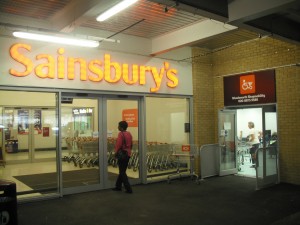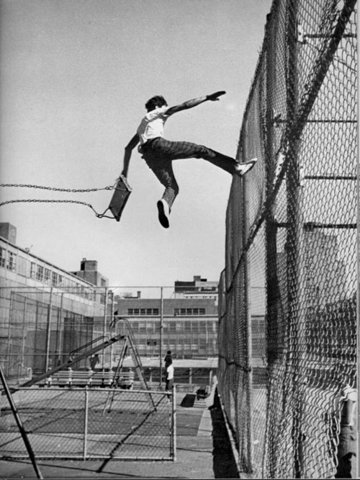The retail sector employs 2.8 million people, over 10% of the total UK workforce. If we want to understand how those workers can develop their power and leverage we need to understand the specifics of their work. It’s in this spirit that we’re sharing this anonymous first hand report from the Sainsbury’s shop floor, explaining the labour process as it is and how it’s being changed by the introduction of new technology and modes of exploitation.
If you’re interested in understanding the massive process of change currently ongoing in the retail sector, you might want to also check out these reports from the Angry Workers of the World.
I work in the ‘Shopping To You’ department (known to us as the STI department) of one of the major Sainsbury’s stores on the south coast as an ‘online shopper’. My job is basically to pack items ordered by customers online. We work in the normal retail stores early in the morning before and just after they open to the public.
The STI department is one of Sainsbury’s largest in terms of labour force, and also one of its most profitable. Our store has upwards of 40 online shoppers, around 15 drivers, 5 marshals, 4 team leaders, 3 managers, and 1 department head. We’re a wide range of ages. The non-leadership positions are occupied by people ranging from their early 20’s to late 50’s with no particular age group holding a majority. Everyday of the week has around 30 shoppers working the 4am-8am shift, with around 20 shoppers staying on until 10am. I am not sure of the number of drivers working each day but I do know that we constantly use all 12 vans for the deliveries, with plans to expand the number of vans.
I‘ve worked as an online shopper for over a year, and I’m going to explain the day-in day-out work process as it has been, and then how nationwide changes coming into effect in late March/early April are going to change it. The ‘new system’ is already in operation at some stores in the country, and all of this information comes from meetings where the managers, who have observed the new process at those trial stores, explain the new system to us.
The work as it is
The typical day of work at STI begins at 4am (a way to avoid paying us a night time premium hourly rate) and runs until either 8am or 10am depending on which contract you have. I don’t know anybody who has a contract that has them work any less than 4 days of work a week. There are also some people with contracts to work 2pm until 6pm, but I have been told the work runs out after a few hours and those shifts are only really busy around Christmas time.
The shopper clocks in and goes to the department to start at 4am. Starting early (to finish early) is strictly prohibited by the night shift management due to complaints from night shift workers that STI workers obstruct their ability to meet their own productivity measures.
The worker has a handset computer and a unique log-in which they use to receive a shopping list for up to 8 different customer orders in one of 4 sections of the shop. The bosses can, and often do, ‘lock’ a worker into a particular section for a few reasons:
* On request of the shopper – For health reasons some workers don’t want to carry out the heavy lifting required in some sections, so will work exclusively in the chilled section. Most workers however avoid chilled like the plague because it’s really cold (The preferred tactic is to go to the toilet for 10 mins until the non-interfered work rotation puts somebody else on it, It’s dog eat dog on chilled).
* To train a shopper on a particular section they are unfamiliar with. (This will last typically a week at most before a shopper returns back to working across the store with every set of shops).
* To co-ordinate our work with the night shift (if the night shift has had their own instructions to fill out a particular part of the shop they sometimes request that STI leaves shopping, or at least operates at a minimum, on that part of the shop until after their shift finishes at 7 am).
*As a disciplinary measure – I was locked into the frozen section for 2 months for talking to colleagues too much (Frozen typically has 2 or 3 people out of the 30 people working on that day).
On logging in the shoppers go to the starting point of their shop. Typically every shopper in that part of the shop starts in the same place. ‘Ambient 1’ at the cereal, ‘Ambient 2’ at the alcohol (which is how I wish I could start those mornings tbh), ‘Chilled’ at the chillers on aisle 15, and ‘Frozen’ at the freezers (obviously). Sometimes the shops can be mixed (so an ambient 1 and 2), but that’s rare.
The handset then directs the worker towards the locations of the items a customer has ordered. The worker then scan the item, places it in 1 of the 8 boxes on their tote, and then either puts the item in a bag if the shop is a ‘bagged shop'[1], doesn’t if it isn’t, or does any way if it’s raw meat or vegetable/fruit with no packaging. At the start of each individual shop the worker writes the order details of that shop onto the corresponding box on a little whiteboard bit.
Every customer gets at least 1 box no matter whats been ordered, and boxes are not mixed between customers. If a particular customer’s shop necessitates that more boxes are used (because they have ordered too much shopping for 1 box), then extra boxes are opened up with the order details on.
Workers have the ability to prematurely end a customers shop by pressing a ‘tote full’ command into the handset if they have no more room on their trolley. The shop is then put back into rotation and reallocated to another worker. Workers also use this command towards the end of their shift or their break time; if a worker has 10 mins until they normally go on their break or leave, but were given a shop that is going to last more than that, the shopper will press ‘tote full’ to end the shop. This is called ‘tote fulling’. The bosses don’t like it, but I don’t know of any disciplinary measures used to prevent it.
Shops last anything from a minute to around an hour depending on how many items they are. The time given for a shop is measured by the handset at roughly 2 items picked a minute. Failure to reach this target results in conversations with the bosses and disciplinary action, but there are no instances of missing productivity targets resulting in a sacking that I know of.
There is no way to ‘pause’ this measurement of productivity, even to go to the toilet, and the measurement continues for the total duration of the handset being turned on. At the end of a shop, when you drop your trolley with the boxes off to the marshals and pick up another trolley the clock is still ticking. At the start of the shop when you are actually going to the start location of the shop you are being measured. While you are helping a customer your clock is still going. It only stops when it is logged off for your 15 minute break or the end of the shift. If you do not get roughly 120 items an hour you are put onto report. We find out our productivity numbers and pick rate once a week.
The handset does not take into account which part of the shop you are working in, but all sections take a different amount of time due to the different proximity of the items. In Chilled everything is closer together so it speeds up. In Ambient 1 you get a lot of multiple items in the vegetable/fruit aisles so this speeds your shop up too. In Ambient 2 there is a lot of heavy lifting for things like bulk buying liquids (bottled water, alcohol, soft drinks etc.) and the shops are typically more spaced out so less time spent picking items and more moving from item to item. On Frozen everything takes much longer.
The work as it will be
I should say again that the changes have not yet come into force, so all this information is based on what we’ve been told by our managers. The changes are supposed to reflect the way in which the shopping delivery service is being developed, expanded, and prioritized by the supermarket industry as a whole. I think that’s because people are so busy they don’t even have the time or energy to do their own shopping any more.
Instead of hiring Christmas temps this year, the department at my store hired about 15 new people, which replaced people leaving and added another 10 or so workers on permanent contracts. These new employees were all put on 4-8am contracts, for 5 days a week.
A few of us longer term employees were asked during the Christmas period if we wanted to change our contract to this model in January. I don’t know anybody who accepted this offer apart from one colleague who instead opted to drop a day because she had another job (there are a lot of colleagues there who work second jobs). The intention behind this, as we were told by the head of the whole store, is to make sure our work on STI is completed by 8am, an hour after the shop opens to the public. This leaves a lot of colleagues like myself who are contracted until 10 am with nothing to do for two hours, which on paper sounds great, but in reality means you either have to go and stack shelves (something you really can’t be bothered to do when you’ve woken up at 2.30am to be at work for 4 am, and walked around the store nonstop for those 4 hours [2].) or you go home and lose 2 hours pay.
We still can’t start early, but whereas before priority was given to the night shift in their job to put as much stock on the shelves as possible, now STI is being prioritized. Under the ‘new system’ the night shift have to leave their rollers and crates with stock at the end of the aisle, and walk back and forth carrying the stock in their arms while STI line their trolleys in the middle of the aisle and work from there. Our productivity is being considered more important than theirs. One of my bosses said that the night shift will ‘just have to work more efficiently’ when I asked about this in a team meeting. It will either force the night shift to work much harder or we’re going to run out of items to pick.
Now the bosses will have no ability to interfere with what the computer allocates in terms of shopping. This has caused concern for those workers who avoid particular zones of the shop for health reasons (back problems for heavy lifting, achy joints/metal implants for chilled). My boss said that individual workers will just have to “reconsider if this is the right role for them in the company” after the new system comes in. It also means that workers are required to be equally proficient on all parts of the shop rather than effectively specializing on 1 or 2 parts of the shop.
Ambient 1 and 2 are now mixed shops, frozen and chilled stay the same. This means a much broader coverage of the store in one shop, which will likely lead to a drop in items picked per hour.
With the new system there is no dedicated starting point for each shop. Now shops can start half way through Ambient 1 and go on Ambient 2, and vice versa. The biggest concern here is that it will be harder to tell who is on each shop with you. Before I’d be able to ask a mate if they were on Ambient 2 next, and if we both were then we’d be able to go around chatting. Now we can’t rely on that. Proper taken the jam out of my doughnut, that has, something much overlooked by Marx. It is unclear if ‘bagged shops’ or ‘un-bagged shops’ will be affected.
The new handset somehow knows the size of each item and the space required for each shop, and now there is no option to ‘tote full’. Before you’d just get items on a list, now you get a list that will definitely fit into your box. How exactly this will affect substitute items nobody seems to know. But, because of the removal of the tote-full command, we are no longer going to be able to take breaks when we want to. The shop has to be finished, and only the bosses can take you off a shop at the end of the shift.
There are apparently no more ‘small shops’, due to the hand set knowing the size required for each shop and knowing the diameters of the box, every shop is maximized to fit 8 customers at full capacity. And now, rather than waiting for your weekly checkup with Dr. Team Leader to be told how healthy your productivity has been, you are now told at the end of every single shop. The consequences of this are not clear. It could really affect team morale negatively (it’s never nice to be told constantly that you are failing, once a week is enough). It could spur people on to try to improve their own productivity, or it could open up a fragile relationship between productivity and effort (remember, some shops are just quicker to complete, a worker knows a particular section better than others, and for those who enjoy a chat ‘happy workers are good workers’).
[1] A bagged shop is a shop where a customer has asked for a bag (which costs a flat rate of 40p no matter how many bags are used. The shopper themselves decides how many bags to use, bosses will have a word if they disagree with the shoppers approach to bagged shops).
[2] A colleague used one of those things you use to measure how many steps you’ve done and after a 6 hour shift it was something like 6 or 7 miles, mental.



